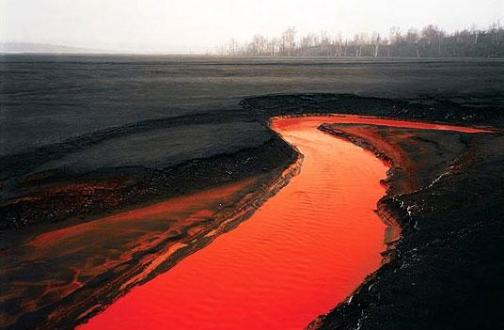 This article was originally published in the Sudbury Star – Friday, February 6 , 2004
This article was originally published in the Sudbury Star – Friday, February 6 , 2004
Sudbury should work extra hard to control its image
Ed Burtynsky is a very successful art photographer who, unfortunately for Sudbury, has become somewhat of a celebrity within the tiny Toronto media establishment. Why should the city be concerned? Mr. Burtynsky’s principal subject matter happens to be industrial environments and many of his photos were taken in the Sudbury region. In fact one particularly photo titled, Nickel Tailings #34, Sudbury, Ontario is not only on the cover of his new book, but is also being highlighted by the Art Gallery of Ontario (AGO) in their media promotions of his show.
If you read last Saturday’s Globe and Mail, you would have seen a “full-page” advertisement for Mr. Burtynsky’s AGO show using a striking photo of a river of slag with denuded trees in the distance. The Globe and Mail is Canada’s most influential newspaper, read by the country’s corporate and political elite – the type of people who make decisions on where factories should be built and where significant government investments should be made.
In the February issue of Toronto Life, journalist Gerald Hannon writes a lengthy profile on Ed Burtynsky’s work and eloquently describes that slag-dump photo as, “One image in particular has become almost iconic. Nickel Tailings #34, Sudbury, Ontario gives us a black and blistered landscape, a fragile line of trees huddling disconsolately in the background, the foreground dominated by a stream so crimson it is as if the earth has bled.”
In a recent review in the Toronto Star, the country’s largest circulation paper, art critic Peter Goddard describes another Burtynksy photo titled #13, Inco Abandoned Mine Shaft, Crean Hill Mine, Sudbury, Ontario as “… that left a pool of lime-green water so toxic and yet so clear – and lovely to look at – that the vertical striations in the rock are reflected in the surface of the deadly pool.”
Taking a Beating
Sudbury’s public relations image is certainly taking a beating. In fact, many in my business might suggest that the past twenty-five years of trying to change the city’s image from a polluted, industrially ravaged moonscape into a transformed, regreened landscape has been dealt a mortal blow!
In 1998, I pitched a story to a Globe and Mail editor about Sudbury’s Convention Bureau and the efforts of its then manager, Paul Brokenshire in attracting business to the city. The editor was amazed that Sudbury even had a convention bureau and that groups of businessmen would consider holding their meetings up there. Since the entire concept seemed like an entertaining tabloid “believe it or not story” he bought the idea.
I made sure I included a photo of the manager standing in front of scenic Ramsey Lake with the Science Centre in the background. However, that experience clearly demonstrated the disconnect between the Toronto media’s perceptions of Sudbury verses the reality.
I have always been a little puzzled at the lack of promotion the city takes in highlighting the community’s attractiveness for economic development.
A quick review of any Canadian business magazine will produce many advertisements from cities like Kitchener-Waterloo, Windsor and North Bay promoting themselves as the best location for economic development. North Bay, which is one third the size of Sudbury aggressively advertises itself in the Toronto print media and certainly puts this community to shame.
Even tiny Elliot Lake is well known in the all important Toronto media as a retirement haven while Sudbury’s reputation still hangs on to its past notwithstanding the U.N. environment awards and the Science Centre. Sudbury has become a well branded cliché in the Canadian psyche for industrial decline, pollution and thanks to Stomping Tom, hard-rock Inco miners.
The city is currently going through its annual budget process and the local politicians should debate the merits of a print advertising campaign in the Toronto media, regardless of the cash constraints. The city’s reputation as a location for economic development is at stake!
PEI with a GDP of $3.4 billion compared to Sudbury’s $5.4 billion has established a comprehensive public relations and advertising campaign for tourism and economic development. They even extensively market themselves in American publications. I don’t think there is a $380 million corporation, (Sudbury’s annual budget) that does not set aside sufficient funds to effectively promote their reputation or corporate image.
Sudbury is a product or brand. It must fight with hundreds of other communities in this country and the United States for business investment. It also has to compete with every other city or town in this province and country for provincial and federal dollars. Why should any level of government invest in a community that appears to be an industrial wasteland whose principle employer the mining sector is considered a low-tech, dying industry?
Whore in a Hovel
In September 1975, when I was still in high school, a Maclean’s magazine journalist named Walter Stewart wrote a column titled “Mister Stewart Goes to Washington”. In that column he unfairly compared Sudbury to other Canadian cities and wrote, “…or Sudbury, which squats in its glum background like a whore in a hovel …”
At the time, many in the city were in an uproar and the local media splashed the offending remarks on their front pages. My English teacher assigned her class to write letters to the editor protesting that slanderous assault on our fair city, and that incident became my first introduction to the incredible power of the media.
But who really cared at that time as Sudbury was one of the wealthiest cities in the country on a per capita basis with almost full employment. In fact, what was the use of attracting more industry to this community since any physically fit male who wanted a job could have one?
How times have changed. Image is everything. One picture is worth a thousand words. You have only a few seconds to catch someone’s attention in this fast paced, digitized world of the web. Anything connected to resource industries are considered yesterday’s technology. Sudbury must start working on a strategic and sustained public relations and advertising strategy for the Toronto media. It must be made an economic development priority.
To do nothing would be like, dare I say it, “squatting in a glum background like a whore in a hovel!”
Stan Sudol is a Toronto-based executive speech writer and mining columnist. www.republicofmining.com
























